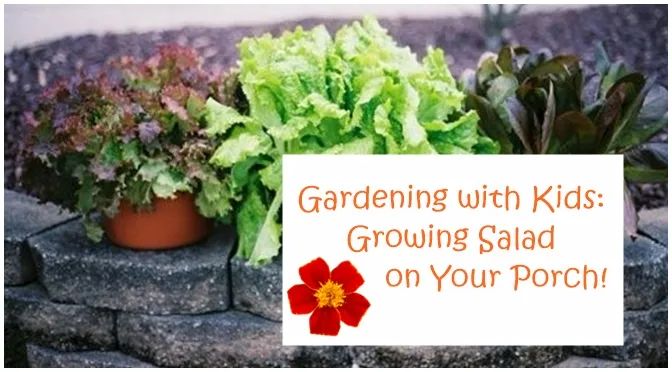
Gardening with Kids: Growing Salad on Your Porch!
Lettuce is one of the easiest garden crops to grow. Going from seed to salad bowl in an average of 4-5 weeks, even children can grow their own “garden in miniature” with leaf lettuce. If you start several containers, one every week or two, your family will be able to harvest and enjoy fresh, living food all summer long. History tells us that Thomas Jefferson planted one thimbleful of lettuce seeds* every Monday morning from early Spring through early Fall at his famous gardens in Monticello so that fresh lettuce would be available all growing season long, and he encouraged others to do the same.Getting Started
Lettuce enjoys cooler temperatures, with seeds germinating in temps as cool as 40 degrees, and germination falling off in temps over 75. In the heat of summer, try starting your seeds in full shade until they sprout, then moving them to part-sun. Lettuce really does well in part-sun situations, meaning 4-6 hours daily of direct sunlight. Less than that and they are likely to become leggy and stressed (can you relate?). More than that and they could “bolt” early, which means that instead of producing lots of crunchy and refreshing leaves to be eaten, the plant puts its energy into producing a single stem that will flower and set seed. That’s fine if you want to save some seed for next time, but, in the meantime the plant leaves become bitter.
We highly recommend using an organic potting soil (available at local nurseries or even big box stores) to grow your lettuce. You will need a container at least 4” deep and up to 10”. Be sure that your container has drainage holes, especially if kids will be helping you water. With a sufficiently deep container and good organic soil (lots of organic, fluffy material to absorb water), you shouldn’t need to water more often than every second or third day once the seeds have sprouted and taken root. For the first two weeks, check and water if needed daily. You will know that it is needed when the soil is not as dark as when freshly wet. After that, water every other or every third day. Just keep an eye on it; it will droop quickly if it feels dehydrated.
Check out the seed packets on display – there are so many varieties of fun lettuces to try! The easiest versions are loose leaf lettuces; head lettuces like Romaine or iceberg need a long growing season. Try the different colors and see if your kids can taste the difference – reds, purples, all shades of green. Some are frilled, some flat, some curly. Some grow tall leaves and others are interesting shapes. Seeds are cheap, and teaching your kids that eating fresh produce can be fun is priceless!
Harvesting Your Crop
When your lettuce has reached a size appropriate for salads, send children out with a bowl and a pair of scissors to snip the leaves off about an inch above the base. Within a few weeks, your little plants will have regenerated another crop!
For smaller children, it might be fun to let them paint or label their own container. Then, give them a particular plastic cup or small watering can with instructions about watering. If they feel a sense of ownership, they are more likely to eat it! And, a little good ranch or mild Italian dressing goes a long way with kids.
You can start planting your own salad bowls any time now! Pull them in only if temperatures are forecast to be below 32; they can handle a frost as long as the roots are not damaged.
*Note – Jefferson was not planting 1 thimbleful of lettuce seed per container, but rather a very large garden space. One seed = one lettuce plant. Sow seed accordingly, or thin as they come up to one plant per 4-6” area.
TOOLS:
- Container of any size or shape, at least 4” deep and wide (bigger is better here)
- Organic potting soil
- Lettuce seedlings or seeds
- Watering can for children, if desired
- Scissors to snip off the lettuce to harvest
